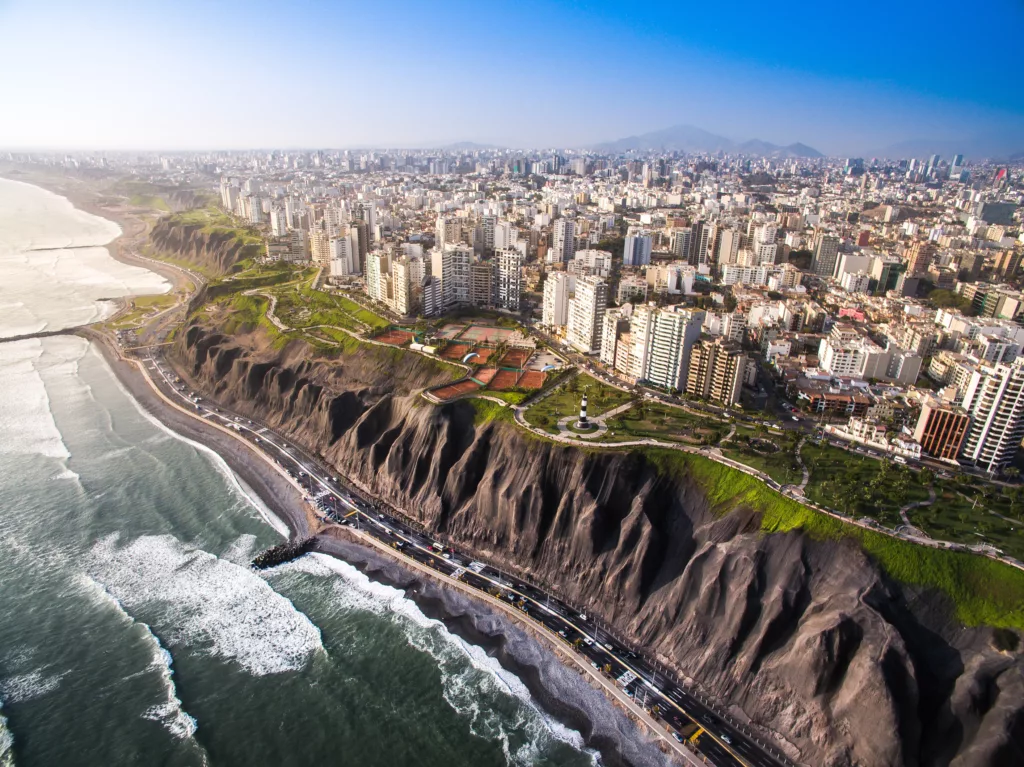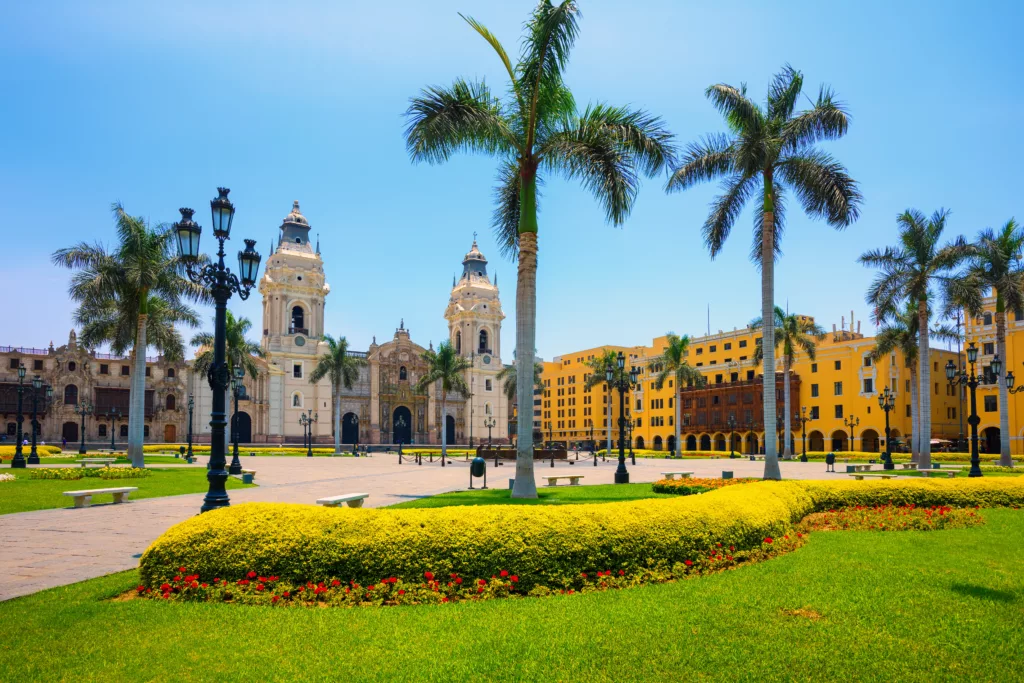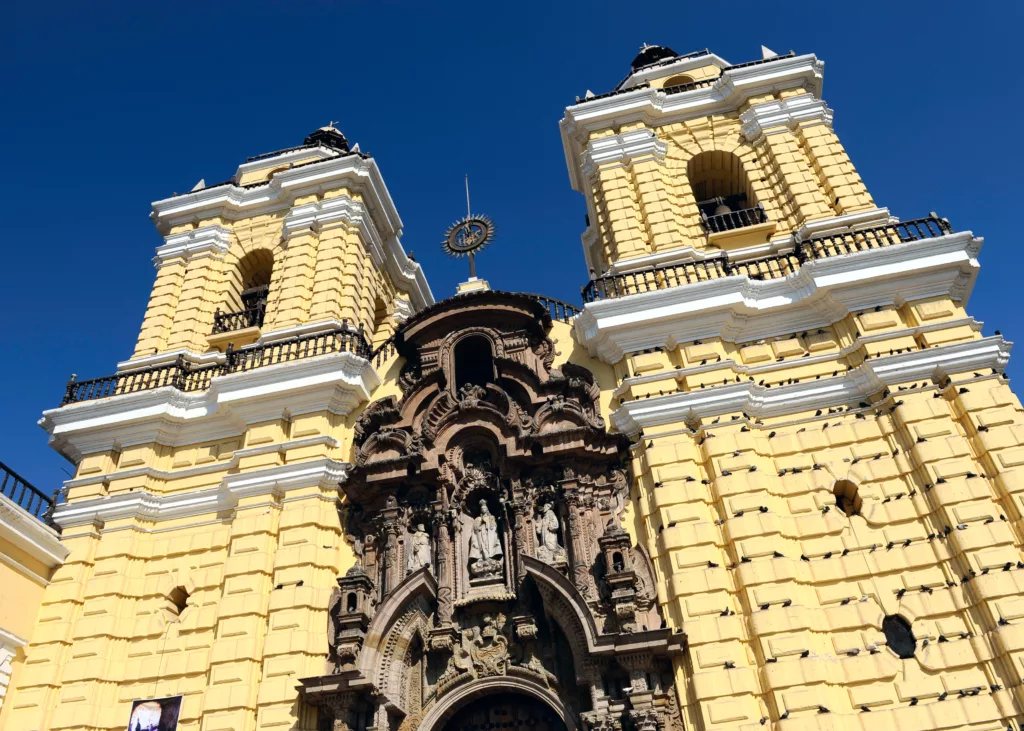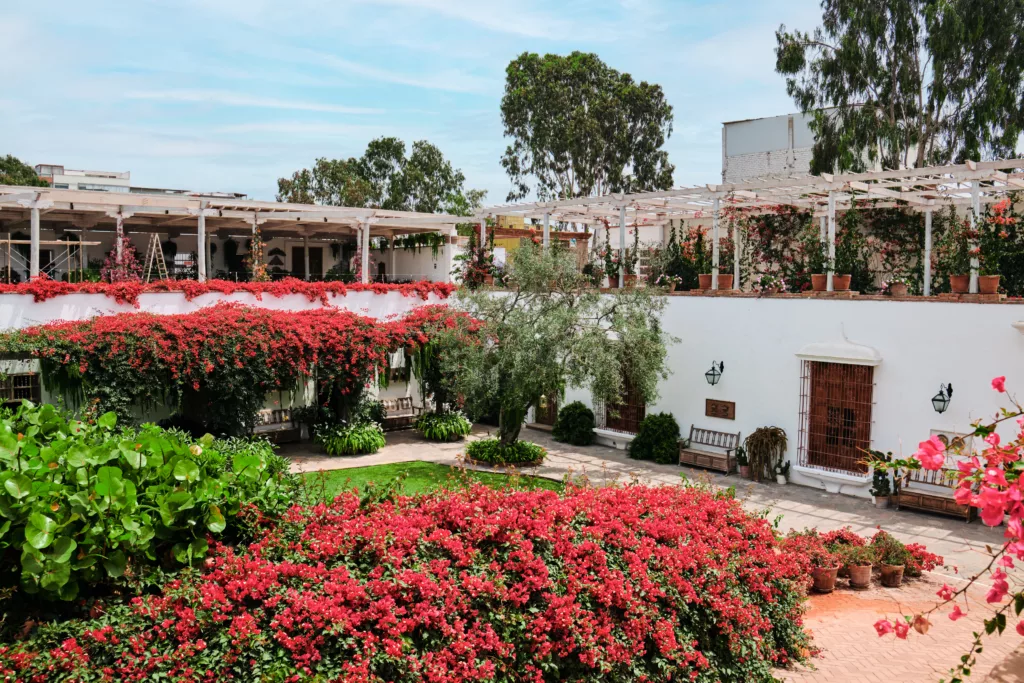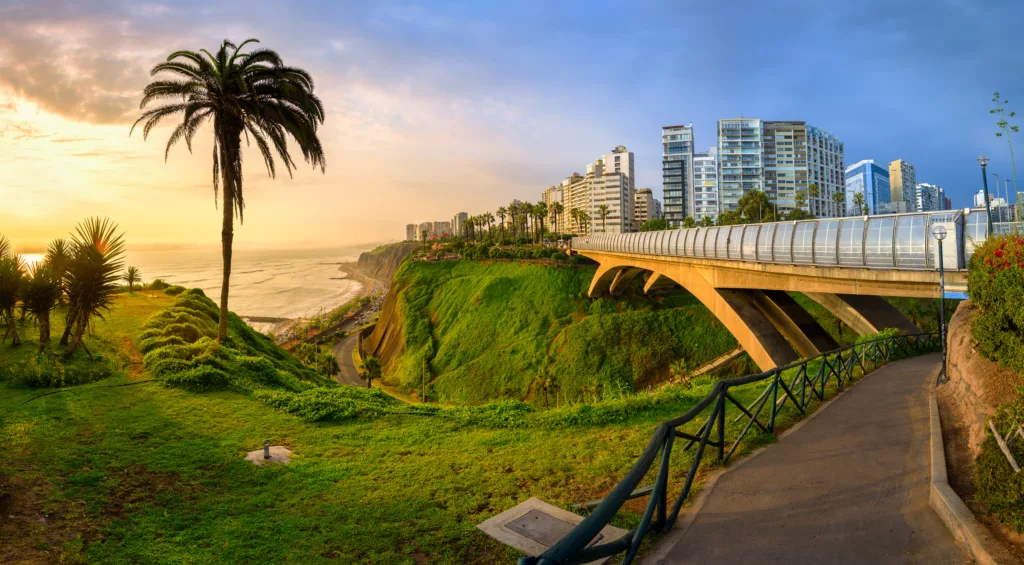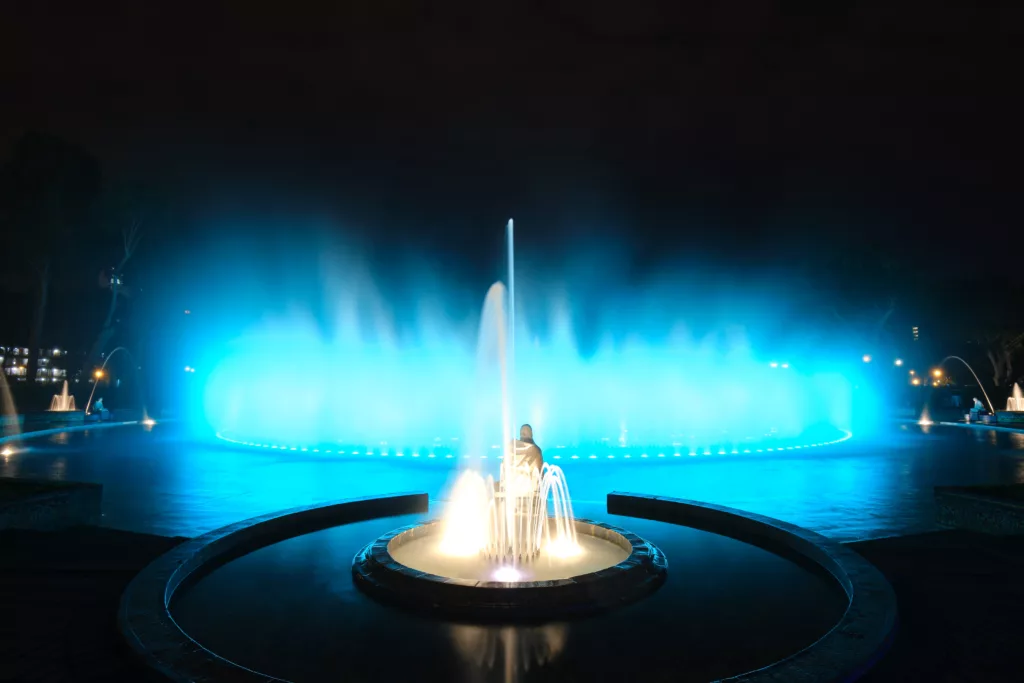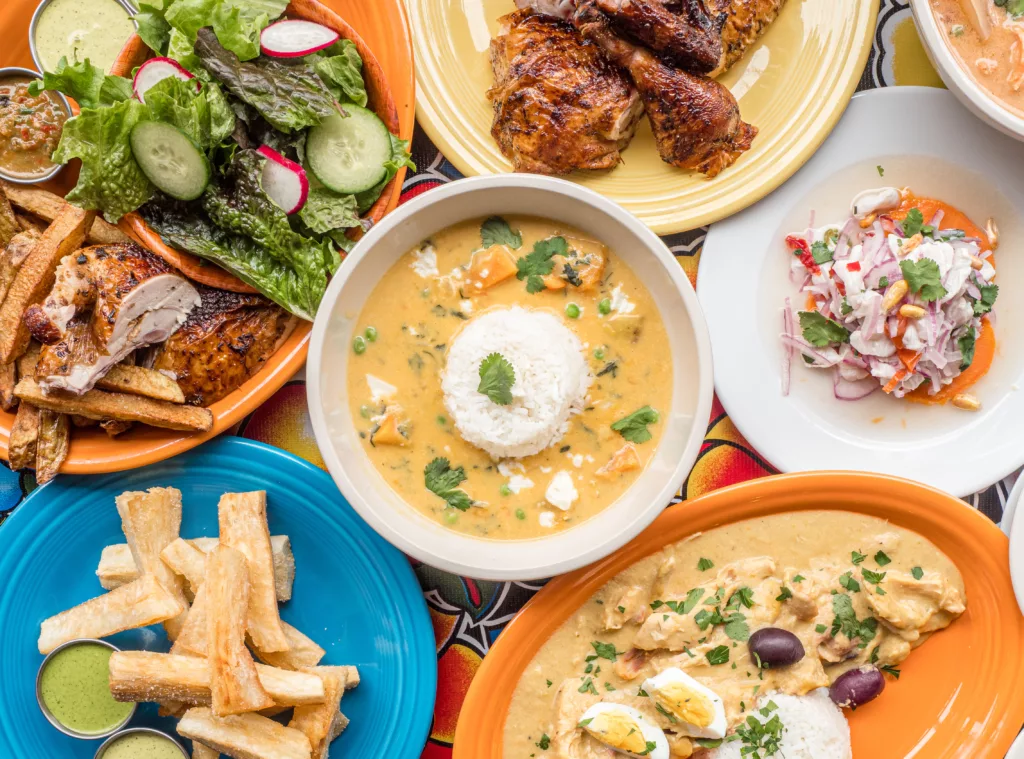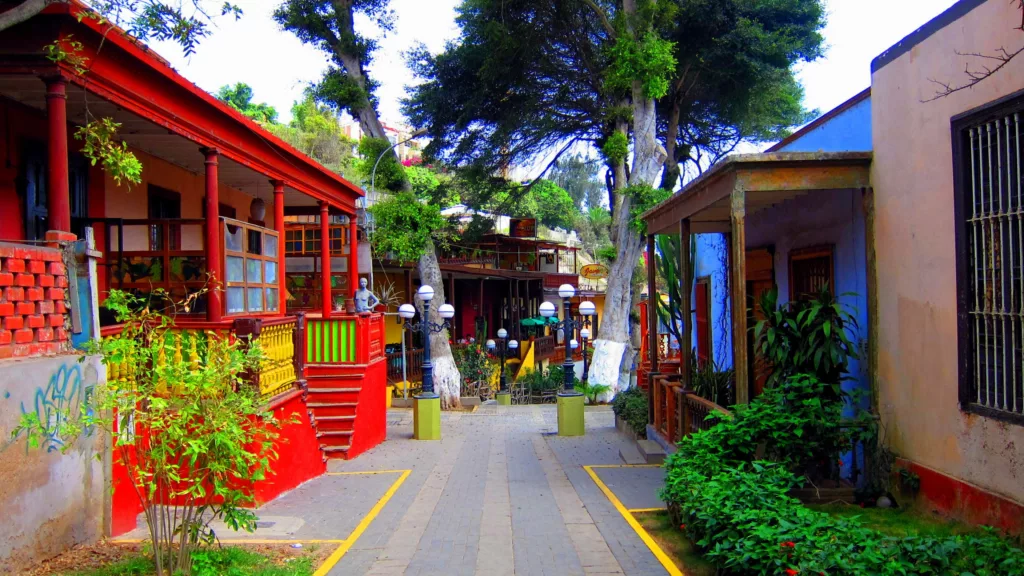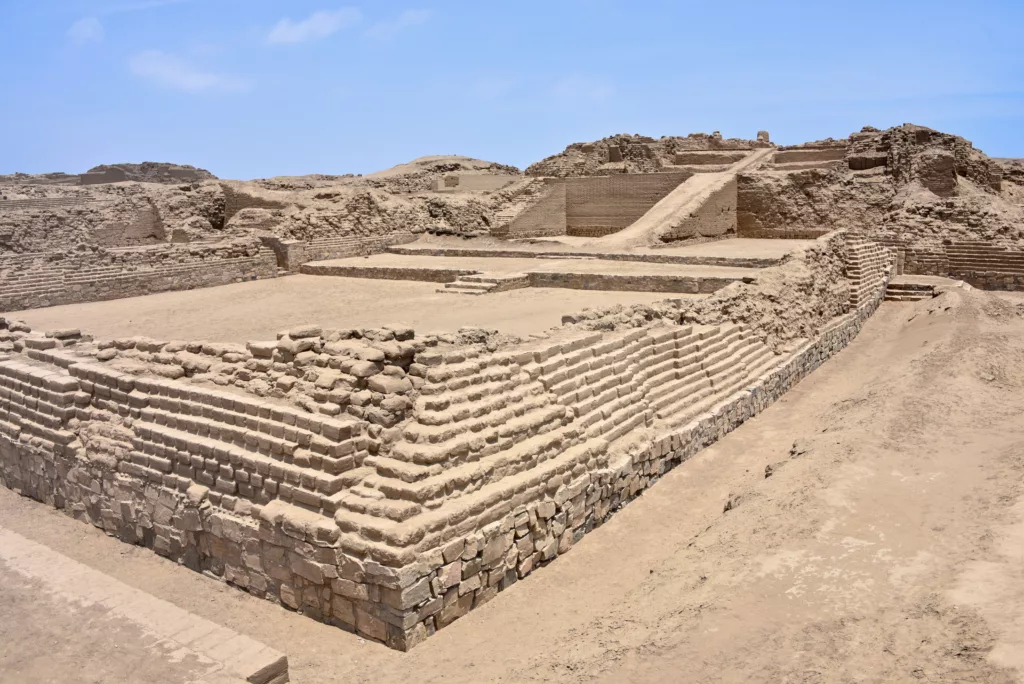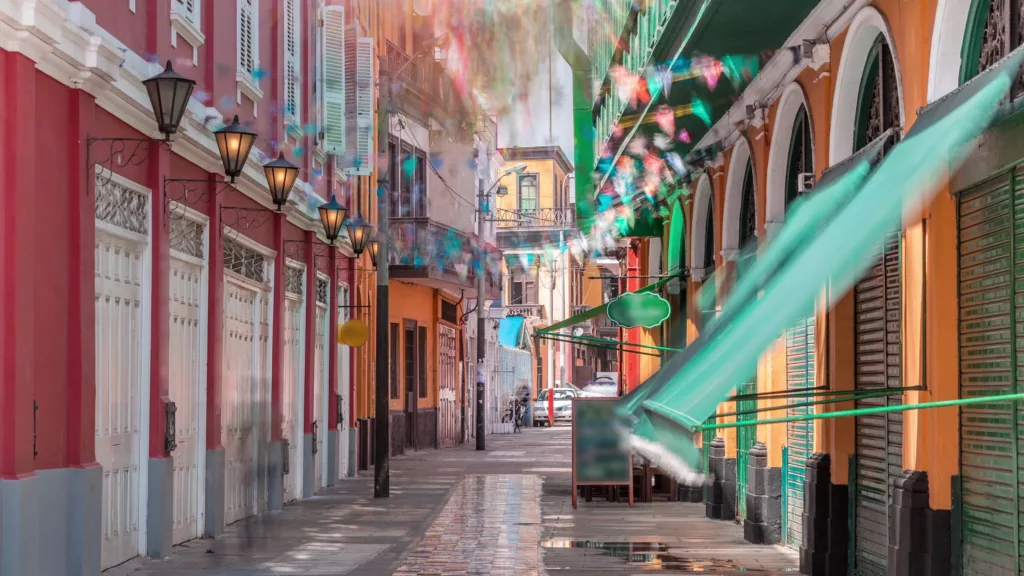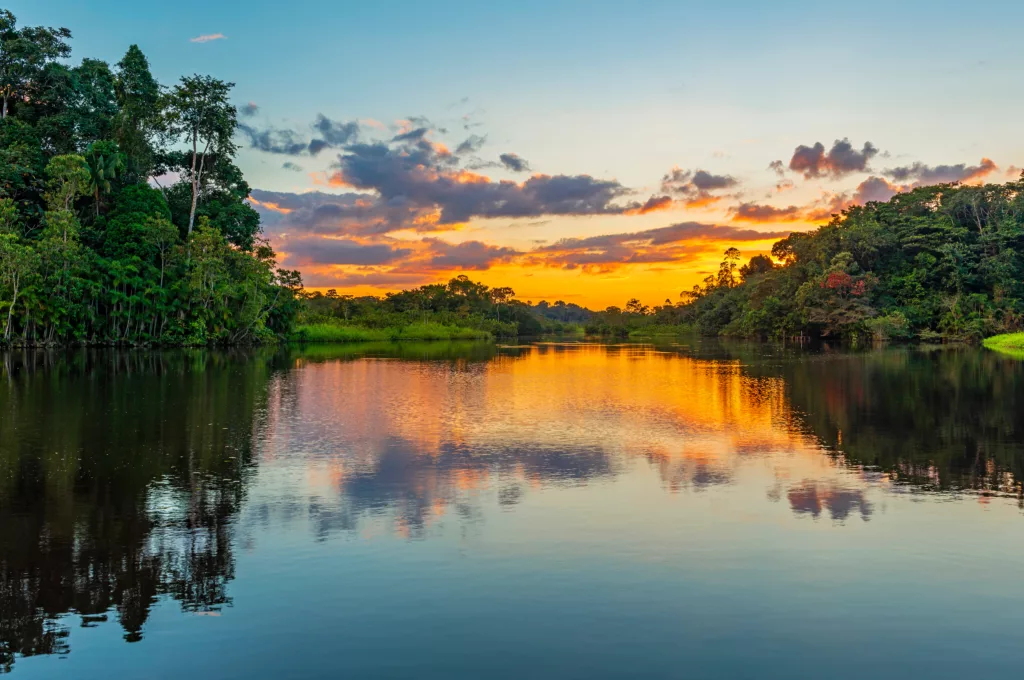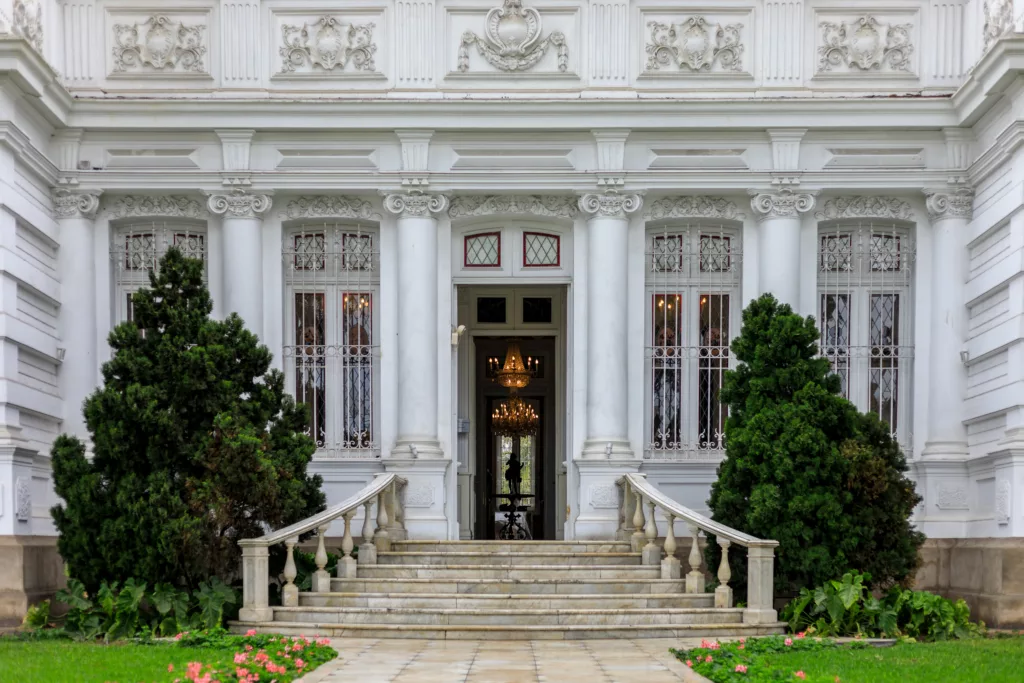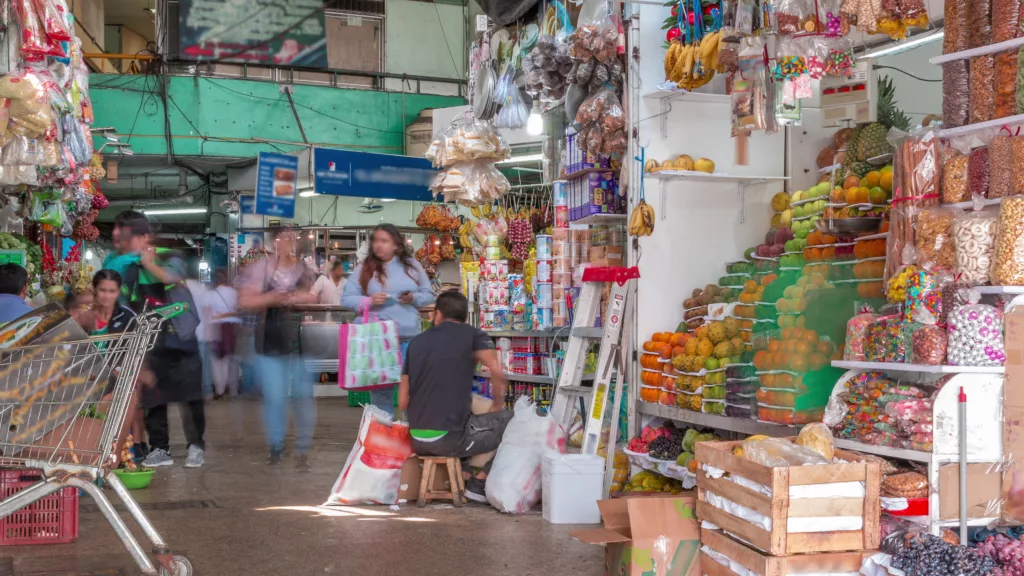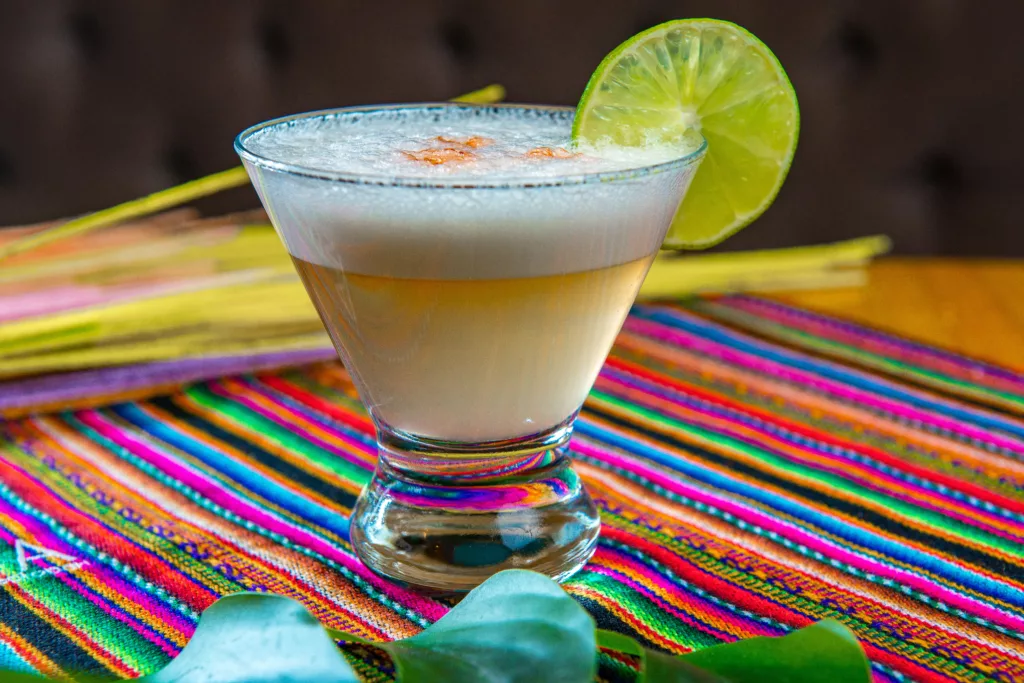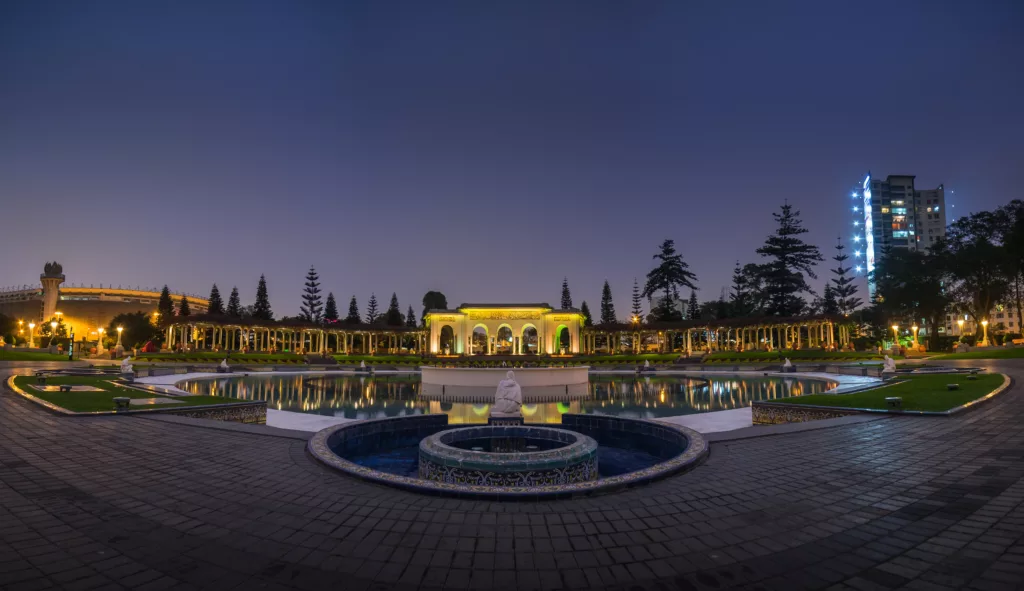Lima, Peru, a city rich in history and teeming with a vibrant culture, offers a dizzying array of memorable experiences that appeal to all types of travelers. Nestled along the Pacific coastline, this South American capital is a treasure trove of architectural beauty, world-class gastronomy, and engaging outdoor activities. For history buffs, the city’s colonial architecture and pre-Columbian ruins provide a fascinating glimpse into the past. Gastronomes can indulge in Lima’s renowned Peruvian cuisine, internationally acclaimed for its innovative fusion of flavors. And for those seeking respite in nature, the city’s beautiful parks and ocean views offer a refreshing contrast to urban exploration. This list, carefully curated to include both iconic sights and hidden gems, serves as a comprehensive guide for the 17 most unforgettable things to do in Lima, Peru, whether you’re a first-time visitor or a seasoned globetrotter.
1. Marvel at the Plaza de Armas
Nestled in the heart of Lima, the Plaza de Armas, also known as Plaza Mayor, is a magnificent square pulsating with life and history. Dotted with intricately designed colonial buildings, this square serves as a portal to the city’s past and is a must-visit location for any traveler.
The Plaza de Armas dates back to the city’s foundation in 1535, laid out by the Spanish conquistador Francisco Pizarro. Serving as the administrative and political center during the Spanish colonial era, it has witnessed many of Peru’s historical events, from the proclamation of Peru’s independence in 1821 to numerous political rallies and demonstrations.
Among the most eye-catching landmarks is the Government Palace, a grand neoclassical edifice serving as the residence of Peru’s president. Also surrounding the square are the Cathedral of Lima, the Municipal Palace, and the Palace of the Union. The Cathedral of Lima, a stunning example of religious architecture, houses the tomb of Francisco Pizarro.
Strolling around the square, you will also notice the beautiful bronze fountain that has stood since 1651. It’s not just a photo opportunity, but a symbol of the city’s resilience and continuity amidst changes.
Voyagix Tips
For an enjoyable and insightful visit to the Plaza de Armas, consider these tips:
- Getting There: The square is located in downtown Lima and is easily accessible by public transportation or taxi.
- Best Time to Visit: Mornings and late afternoons are the best times to visit as the square is less crowded, and the lighting is perfect for photographs.
- What to Bring: Don’t forget your camera to capture the architectural beauty and your ID as some buildings may require identification for entry.
- Respect Local Customs: Remember that the square is not just a tourist destination but a part of the daily lives of Lima’s citizens. Respect the local etiquette and be mindful of your surroundings.
The Plaza de Armas, with its rich tapestry of history and vibrant daily life, truly encapsulates the spirit of Lima. Its stunning colonial architecture and historical significance make it a must-visit destination for any traveler in Lima.
2. Visit the Monastery of San Francisco
Boasting an impressive facade of yellow edifice adorned with intricate carvings, the Monastery of San Francisco is one of Lima’s most compelling architectural marvels. Known as an epitome of Spanish Baroque architecture, the monastery is renowned for its splendid design, decorative courtyards, and intriguing catacombs.
Established in the 17th century, this grand structure houses a church, convent, and two remarkable cloisters, Capilla de la Soledad and El Patio del Crucero. Inside, visitors can admire the stunning Mudejar ceiling in the main nave, a testament to the influence of Islamic art in Spanish architecture.
One of the monastery’s key features is its library. Housing an estimated 25,000 antique texts, some dating back to the 15th century, the library is a treasure trove for historians and bibliophiles. It’s been likened to Harry Potter’s Hogwarts for its antique ambiance.
Perhaps the most fascinating and eerie aspect of the Monastery of San Francisco is its catacombs. Serving as a burial site until 1808, the catacombs contain an estimated 70,000 remains. The bone arrangements and the labyrinth-like tunnels provide an intriguing yet chilling experience.
Voyagix Tips
For a meaningful visit to the Monastery of San Francisco, consider these tips:
- Getting There: The monastery is located near the Plaza de Armas.
- Best Time to Visit: The monastery is less crowded early in the morning or late in the afternoon. It’s also worth noting that it closes between 11:30 am and 3:00 pm.
- What to Bring: A camera for the stunning architecture and a light jacket for the cool catacombs.
- Tour Guide: It’s mandatory to join a guided tour to visit the catacombs. The tours are available in multiple languages, including English and Spanish.
Whether you’re an architecture enthusiast, history buff, or an explorer, the Monastery of San Francisco offers an enriching experience. Its grandeur and mystery make it one of the must-visit sights in Lima.
3. Explore the Larco Museum
For history enthusiasts and curious explorers alike, a visit to the Larco Museum in Lima is an enriching journey into the heart of Peru’s rich past. This privately owned museum, located in the Pueblo Libre District, is housed in an 18th-century vice-royal mansion built over a 7th-century pre-Columbian pyramid. The museum’s vast collection of pre-Columbian artifacts provides profound insights into the diverse cultures that have shaped Peru.
The Larco Museum is renowned worldwide for its carefully curated collection of over 50,000 pots, providing an unparalleled overview of 5,000 years of Peruvian pre-Columbian history. The museum’s ceramics collection, featuring pieces from the Cupisnique, Chimu, Chancay, Nazca, and Inca cultures, is especially renowned.
Perhaps one of the most intriguing parts of the Larco Museum is its famous gallery of pre-Columbian erotic pottery. This unique exhibition reveals the ancient Peruvians’ realistic and naturalistic approach towards human sexuality.
Besides its extensive collection, the museum is also noted for its beautiful setting. The museum’s enchanting gardens, filled with lush native flora, are the perfect place to relax and reflect on Peru’s fascinating history after your museum tour.
Voyagix Tips
For a fulfilling visit to the Larco Museum, consider these tips:
- Getting There: The museum is located in the Pueblo Libre District.
- Best Time to Visit: The museum is open every day of the year, and visiting during the morning or late afternoon allows for a more peaceful exploration.
- What to Bring: Don’t forget your camera, and if you plan on reading more about the exhibits, bringing a pair of glasses would be helpful.
- Tour Guide: An English-speaking guide can be hired at the entrance, or you can opt for the audio guide. Both offer detailed insights into the exhibits.
The Larco Museum offers a truly enlightening experience for those looking to delve deeper into Peru’s rich pre-Columbian history. Its vast collection and stunning setting make it an unmissable part of any trip to Lima.
4. Stroll Along El Malecón
For travelers looking to soak up the vibrant seaside ambiance of Lima, a stroll along the El Malecón boardwalk is an absolute must. Stretching over six miles through the city’s upscale Miraflores district, El Malecón offers an enticing combination of lush green parks, stunning art installations, and panoramic views of the Pacific Ocean and the city.
El Malecón is a beloved local spot, frequented by both residents and tourists. It’s a haven for outdoor enthusiasts, with well-maintained jogging paths, bike lanes, and workout stations. The boardwalk is also dotted with a series of beautiful parks, including Parque del Amor with its famous “El Beso” statue, a testament to the city’s romantic side.
One of the most thrilling experiences at El Malecón is watching paragliders launching off the cliffs into the ocean breeze, their colorful wings adding a dash of adventure to the serene cityscape. And as the day winds down, the boardwalk is the perfect spot to witness a breathtaking sunset over the Pacific, a moment that truly encapsulates Lima’s coastal charm.
Voyagix Tips
Here are some helpful tips to ensure you enjoy your visit to El Malecón:
- Getting There: El Malecón is located in the Miraflores district. Taxis, buses, and bike rentals are convenient options to get there. It’s a well-known location, so most drivers will know the route.
- Best Time to Visit: The boardwalk is beautiful at any time, but for a truly magical experience, aim to visit during the late afternoon to early evening when you can enjoy a mesmerizing sunset over the Pacific Ocean. Also, weekdays are generally less crowded than weekends.
- What to Bring: Don’t forget your camera to capture the stunning views. Wearing comfortable shoes is advisable for the walk, and if you plan on staying till sunset, you might want to bring a light sweater as it can get a bit chilly.
- Stay Active: El Malecón is perfect for outdoor activities. You could rent a bike or rollerblades from one of the nearby rental shops, or if you’re feeling adventurous, try paragliding for a bird’s-eye view of the city.
A scenic walk along El Malecón is a captivating experience, blending the lively city atmosphere with the calming influence of nature. The panoramic views, lush parks, and engaging activities make it a highlight of any trip to Lima.
5. Experience the Magic Water Circuit
As evening descends upon Lima, one attraction transforms into a world of color and light. The Magic Water Circuit in the Parque de la Reserva is a must-see spectacle that artfully blends light, water, and music to create an immersive show like no other. Being the largest fountain complex in the world, it holds a Guinness World Record for its incredible display.
The Magic Water Circuit is home to 13 distinct fountains, each one providing a unique show. Perhaps the most prominent feature is the Fuente Mágica, a massive fountain that shoots water over 80 meters into the air. Another favorite is the Túnel de las Sorpresas, a 35-meter walk-through tunnel of water that creates an enchanting experience.
The highlight of the park, however, is the Fantasia Fountain. This fountain serves as the stage for the central show where lasers and colored lights dance across the sprays of water, all choreographed to a soundtrack that evokes Peru’s rich cultural history.
The Magic Water Circuit is a feast for the senses, providing both locals and tourists with a place to relax, explore, and be entertained in the heart of Lima.
Voyagix Tips
To enjoy your visit to the Magic Water Circuit, here are some useful tips:
- Timing: The park opens in the afternoon, but the magic truly begins after sunset when the light shows start. Check the official website for the current schedule.
- Duration: Allow at least two hours to fully enjoy all the fountains and the main light and water show.
- Tickets: Entry is ticketed, and it’s recommended to buy tickets in advance during peak seasons.
- What to Wear: Some fountains allow interaction, so you might get a little wet. It’s advisable to wear comfortable, water-resistant clothing and footwear.
A visit to the Magic Water Circuit provides a mesmerizing end to a day in Lima, leaving you with unforgettable memories of this spectacular city.
6. Dive into Peruvian Cuisine
One of the best ways to truly immerse yourself in the local culture during your visit to Lima is by indulging in the city’s exquisite cuisine. Known as the culinary capital of South America, Lima offers an exciting gastronomic adventure with its blend of traditional and contemporary dishes. Relish the authentic flavors of Peruvian Cuisine at the local eateries dotted around the city, and taste a slice of Lima’s rich culinary heritage.
Begin your culinary journey with ceviche, the national dish of Peru. This refreshing dish features fresh, raw fish marinated in citrus juices and spiced with aji or chili peppers. It’s typically served with sweet potato and corn, creating a perfect harmony of flavors. You’ll find some of the best ceviche in Lima at popular spots like La Mar and Pescados Capitales.
Next, sample anticuchos, a popular street food in Peru. These skewers of marinated beef heart are barbecued to perfection and served with a side of boiled potatoes and corn. Try them at Anticuchos Tio Mario for an authentic experience.
Complete your culinary adventure with picarones, Peruvian doughnuts made from sweet potatoes and squash, then drenched in a sugary syrup. A classic dessert, these treats are the perfect way to satisfy your sweet tooth. Look for them at local food markets or dessert shops like Picarones Mary.
Voyagix Tips
When exploring Lima’s food scene, keep these tips in mind:
- Street Food: Lima’s street food is a highlight of its culinary scene. However, make sure to eat at busy stalls as high turnover means fresher food.
- Try a Variety: From seafood to meats to vegetables, Peruvian cuisine is incredibly diverse. Don’t limit yourself to just one type of dish.
- Cooking Classes: If you fall in love with the flavors of Peru, consider taking a cooking class to learn how to recreate these dishes at home.
- Drink Local: Complement your meals with local beverages like Pisco Sour, Chicha Morada, or Inca Kola for the full Peruvian experience.
From ceviche to anticuchos to picarones, Lima’s food scene is a culinary delight that offers a tangible and delicious insight into the city’s culture and traditions.
7. Discover Barranco District
Immerse yourself in the colorful soul of Lima by visiting the Barranco District. Known as Lima’s bohemian hub, Barranco is a vibrant blend of traditional and contemporary, where old colonial architecture meets thriving street art, creating an environment that is both nostalgic and electrifying.
One of the most iconic landmarks in Barranco is the Puente de los Suspiros or the Bridge of Sighs. This charming wooden bridge is not only a historic piece but also a symbol of romanticism in Lima. The alleys leading to and from the bridge are filled with artistic murals, showcasing the district’s thriving art scene.
The district is also home to the MATE Museum, founded by renowned fashion photographer Mario Testino. Here, you can appreciate exhibits of his photography, alongside rotating exhibits of contemporary art.
In addition, Barranco offers a lively nightlife with bars and restaurants set in refurbished colonial mansions. The Ayahuasca Bar is one such place, where you can taste unique cocktails in a stunning setting. Music enthusiasts should not miss the La Noche Barranco, a favorite venue for live performances.
Voyagix Tips
Here are some tips to make the most of your visit to Barranco:
- Getting Around: Barranco is best explored on foot, allowing you to wander through its colorful streets and alleyways at your own pace.
- Art Tours: Consider taking a guided street art tour to fully appreciate the district’s vibrant art scene.
- Food and Drink: Don’t miss out on the district’s culinary delights. Try traditional dishes at local eateries and enjoy a cocktail at one of the many trendy bars.
- Visit During: The district is charming at any time, but it’s particularly lively in the evenings when the bars and music venues come to life.
Imbued with an irresistible bohemian spirit, the Barranco District offers a rich, vibrant experience that provides a deeper understanding of Lima’s culture and lifestyle. Breathe it all in and let Barranco’s charm captivate you.
8. Tour the Pachacamac Ruins
Take a step back in time by visiting the Pachacamac Ruins, an ancient archaeological site located just a short distance from Lima. Nestled in the Lurín Valley, this pre-Columbian citadel offers a captivating glimpse into Peru’s rich history and the mystique of ancient cultures.
Founded around 200 AD, Pachacamac was a religious and ceremonial center for various cultures, including the Lima culture, the Wari, and the Inca. Its name, translating to “Earth Maker”, is a testament to its original purpose as a temple dedicated to Pachacamac, the god believed to have created the world and everything in it.
The site covers a vast area and includes several pyramids, temples, and palaces. Noteworthy structures include the Temple of the Sun, a towering structure constructed by the Incas, offering panoramic views of the surrounding area, and the Temple of Pachacamac, an earlier construction believed to have been the main place of worship.
A visit to the site is incomplete without a stop at the Pachacamac Site Museum, which houses a collection of artifacts unearthed from the area, including pottery, textiles, and mummies, providing further insight into the site’s historical and cultural significance.
Voyagix Tips
For an enriching visit to the Pachacamac Ruins, consider these tips:
- Guided Tours: A guided tour is highly recommended to fully appreciate the historical significance of the site. You can book tours through reputable agencies or on-site upon arrival.
- Preparation: Wear comfortable shoes for walking on uneven terrain, bring sun protection like a hat and sunscreen, and carry water to stay hydrated.
- Getting There: Pachacamac is about 40 km south of Lima. You can reach there by public transportation, taxi, or with a tour group.
- Time: Plan to spend at least half a day exploring the site and the museum.
Embark on a journey of discovery at the Pachacamac Ruins. As you walk amidst these ancient structures, you’ll be captivated by the timeless allure and mystique of Peru’s ancient cultures.
9. Visit the Callao Monumental
Embark on a vibrant journey through Lima’s art, food, and culture at Callao Monumental. Situated in the historic district of Callao, this urban regeneration project has transformed the neighborhood into a vibrant cultural hub, bursting with colorful street art, innovative galleries, delightful gastronomy, and creative spaces.
Once a run-down area, Callao Monumental is now a canvas for local and international artists who bring the city’s walls to life with their vivid murals. As you stroll down the lively streets, you’ll be surrounded by beautiful street art, showcasing a blend of traditional Peruvian themes and modern influences.
Beyond its vibrant exterior, Callao Monumental is also home to a host of art galleries and cultural spaces. Don’t miss the Fugaz Gallery, a multi-story building featuring works from emerging and established artists. Explore its rooms filled with thought-provoking art and step onto the rooftop for a splendid view of Callao’s historic cityscape.
Furthermore, Callao Monumental has a flourishing culinary scene. Indulge in the gastronomic delights at La Bonbonniere, a restaurant located in a restored colonial mansion, where you can enjoy gourmet dishes amidst an ambience of historic elegance.
Voyagix Tips
Maximize your visit to Callao Monumental with these handy tips:
- Guided Tours: To fully appreciate the district’s art and history, consider joining a guided tour. You can find various options on the official Facebook page.
- Comfortable Clothing: Dress comfortably for walking and bring a hat or umbrella for sun protection.
- Camera: Don’t forget your camera! Callao Monumental is a paradise for photography enthusiasts.
- Plan Your Visit: While the district is open all day, the art galleries usually operate between 11 AM and 6 PM. Also, try to visit on weekends when local vendors set up food stalls and artisanal markets.
Immerse yourself in the rich tapestry of art, food, and culture at Callao Monumental, and witness first-hand how this colorful urban regeneration project is breathing new life into Lima’s historic district.
10. Take a Surfing Lesson
Embrace the thrill of the Pacific by catching some waves at Costa Verde. This enchanting coastline, stretching from Miraflores to Chorrillos, is a renowned hotspot for surfing in Lima, offering perfect conditions for both seasoned surfers and beginners alike.
Costa Verde boasts a wide range of beaches, each with its own unique vibe. From the bustling shores of Waikiki Beach in Miraflores to the tranquil waves of La Herradura in Chorrillos, there is a beach to match every surfer’s dream. With constant swells throughout the year, the coast offers an excellent opportunity to ride the waves regardless of the season.
What’s more, the coastline is dotted with numerous surf schools, such as Pukana Surf School and Olivos Surf Camp, offering lessons for all levels. Whether you’re trying out surfing for the first time or hoping to master your skills, professional instructors are ready to guide you through the journey.
Apart from the adrenaline-pumping surf experience, the coastline also offers breathtaking views of the ocean and the city. Catching the sunset after an exhilarating surf session is an experience not to be missed.
Voyagix Tips
Here are some handy tips to enhance your surfing experience at Costa Verde:
- Surf Schools: Check out the websites of Pukana Surf School for lesson details and bookings.
- Equipment: Surf schools typically provide all necessary equipment. However, if you’re a seasoned surfer and prefer your own gear, there are several surf shops along the coast where you can rent or buy gear.
- Safety: Always remember to follow safety instructions provided by your instructors and respect the sea. Don’t venture out alone if you’re new to the sport.
- Post-Surf Activities: After surfing, relax at one of the many restaurants or cafes dotting the coastline, offering delicious Peruvian food with a view.
Dive into the surfing culture at Costa Verde and enjoy an unforgettable experience riding the waves against the backdrop of Lima’s stunning skyline. This is a true Peruvian coastal adventure not to be missed.
11. Explore the Peruvian Amazon
If you have some time to spare on your Peruvian adventure, consider venturing off the beaten path for an unforgettable journey into the Peruvian Amazon. A world away from Lima’s bustling urban landscape, the Amazon Rainforest is an ecological wonderland, teeming with a diversity of wildlife and rich indigenous cultures that will leave you in awe.
The Peruvian Amazon occupies almost 60% of the country’s total area, making it one of the most biologically diverse regions on the planet. From exotic birds and mammals to countless species of plants and insects, each expedition into this lush rainforest offers a unique and exciting encounter with nature.
Many travelers start their Amazon adventure from Iquitos, the largest city in the world inaccessible by road. Here, you can embark on river cruises along the mighty Amazon River, visit animal rescue centers such as the Amazon Rescue Center, and immerse yourself in the region’s rich biodiversity.
Another highlight is exploring the traditions and cultures of the indigenous communities living in harmony with the rainforest. Their invaluable knowledge of the Amazon and sustainable practices offer fascinating insights into the relationship between humans and nature.
Voyagix Tips
Planning a side trip to the Peruvian Amazon? Here are some tips:
- Best Time to Visit: The Amazon can be visited all year round, but the dry season (May to October) is typically more comfortable for travel. Visit the official Peru travel guide for more information.
- Pack Right: Bring lightweight, long-sleeved clothing for protection against insects, a good quality insect repellent, waterproof boots, and binoculars for wildlife spotting.
- Responsible Travel: Respect the local communities and biodiversity. Follow the guidelines provided by your guide or tour operator to ensure a sustainable travel experience.
- Health Precautions: Certain vaccinations may be recommended for travel to the Amazon. Check with your doctor or local health clinic before your trip.
Embark on a side trip to the Peruvian Amazon, and step into a world brimming with life and color. From witnessing the intricate dance of biodiversity to engaging with local cultures, this adventure promises to be an unforgettable chapter of your Peruvian journey.
12. Visit the Museo Pedro de Osma
Dive into Peru’s colonial past at the Museo Pedro de Osma. Nestled in the Barranco district, this impressive museum houses one of the most significant collections of colonial art and artifacts in the country, offering visitors a fascinating insight into the rich historical tapestry of the region.
The Museo Pedro de Osma was established by the philanthropist Pedro de Osma Gildemeister, who dedicated his life to the preservation of Peruvian art. Housed in his beautifully restored 19th-century mansion, the museum showcases a wide array of items, from colonial-era paintings, sculptures, and textiles, to intricate silverware and furniture, each piece revealing a different facet of Peru’s past.
The museum’s collection spans three centuries of colonial art, including works from the Cusco School, a renowned artistic movement in the Spanish colonial period. One of the museum’s highlights is the richly detailed religious art that reflects the fusion of indigenous and Spanish cultures.
A visit to Museo Pedro de Osma also allows you to enjoy the surrounding French-style gardens, which feature charming sculptures and a variety of native plants. This tranquil setting offers a peaceful retreat from the city’s hustle and bustle.
Voyagix Tips
Enhance your visit to Museo Pedro de Osma with these handy tips:
- Plan Your Visit: Check the museum’s official website for current opening hours and exhibition information.
- Tours: To better understand the colonial art and history, consider booking a guided tour of the museum.
- Location: The museum is located in Barranco, so combine your visit with a walk around this bohemian district, known for its vibrant art scene and colonial architecture.
- Museum Cafe: After exploring the museum, relax at the on-site cafe and enjoy a cup of traditional Peruvian coffee.
A journey through the Museo Pedro de Osma offers a unique perspective on Peru’s colonial history and art. Immerse yourself in the past as you wander through the museum’s captivating collection, and gain a deeper appreciation for Peru’s rich cultural heritage.
13. Check Out Mercado de Surquillo
For a taste of everyday Lima, take a trip to the Mercado de Surquillo. This bustling market is a feast for the senses, brimming with fresh produce, seafood, and a variety of local delicacies. As one of Lima’s most traditional food markets, it’s a vibrant place where locals shop and food lovers delight in the city’s rich culinary scene.
Mercado de Surquillo is divided into different sections, each with its own distinct character. The fruit and vegetable stalls offer an impressive range of local and exotic produce. From the vibrant colors of tropical fruits to the earthy hues of root vegetables, it’s a kaleidoscopic display of Peru’s agricultural bounty.
The market is also renowned for its fresh seafood section, where you’ll find a selection of the day’s catch from the nearby Pacific Ocean. As Peru is famous for its seafood, particularly its ceviche, this is a great opportunity to discover the ingredients that make up this national dish.
Don’t miss the chance to sample some local delicacies at the food stalls scattered throughout the market. Whether you’re tempted by the rich flavors of anticuchos (marinated beef hearts) or the sweet taste of picarones (Peruvian doughnuts), there’s plenty to satisfy your cravings.
Voyagix Tips
Get the most out of your visit to Mercado de Surquillo with these helpful tips:
- Plan Your Visit: The market is usually less crowded in the early morning.
- Try Local Delicacies: Be adventurous and sample local dishes. Many stalls offer tasting portions, allowing you to try a variety of foods.
- Guided Tours: Consider a guided tour of the market for a deeper understanding of Peruvian cuisine and ingredients.
- Bring Cash: Many vendors don’t accept cards, so it’s best to bring cash in small denominations.
Exploring Mercado de Surquillo is an immersive way to experience Lima’s dynamic food scene and local life. With its lively atmosphere and array of tantalizing foods, it’s a culinary adventure you won’t forget.
14. Enjoy a Pisco Sour
When in Lima, treat yourself to a Pisco Sour, Peru’s national cocktail, at a local bar or restaurant. An iconic part of Peruvian culture, this delightful concoction of pisco, lime juice, syrup, egg white, and a dash of Angostura bitters is a must-try for any traveler.
Pisco is a grape brandy produced in Peru’s wine-growing regions. The spirit has a unique flavor profile, ranging from sweet and fruity to dry and aromatic, depending on the type of grape used in its production. The ‘sour’ in Pisco Sour comes from the zesty punch of fresh lime juice, perfectly balancing the sweetness of the syrup and the potency of the pisco.
The creation of Pisco Sour is attributed to American bartender Victor Vaughen Morris, who introduced the cocktail at his Lima bar in the early 20th century. Since then, it has become a symbol of Peruvian identity and a staple on the country’s cocktail menus.
Many bars and restaurants in Lima serve Pisco Sour, from historic establishments like the Gran Hotel Bolivar, known for its ‘Catedral’ size Pisco Sours, to modern cocktail lounges offering creative twists on the classic recipe. Some places even offer Pisco Sour making classes, where you can learn the art of crafting this iconic cocktail.
Voyagix Tips
Here are some tips to enhance your Pisco Sour experience in Lima:
- Try Different Varieties: Pisco comes in several varieties, each with its distinct flavor profile. Don’t hesitate to sample Pisco Sours made with different types of pisco.
- Celebrate Pisco Sour Day: If you’re in Peru on the first Saturday of February, join the locals in celebrating National Pisco Sour Day. Many bars and restaurants offer special promotions.
- Responsible Drinking: Pisco Sour is a potent cocktail. Remember to drink responsibly.
- Pisco Sour Class: If you’re interested in making your own Pisco Sour, check out the cocktail classes at the Lima Gourmet Workshop.
A trip to Lima wouldn’t be complete without sipping a Pisco Sour. Whether you’re toasting to a successful journey or simply enjoying Lima’s vibrant nightlife, this beloved cocktail is the perfect companion to your Peruvian adventure.
15. Visit Casa de Aliaga
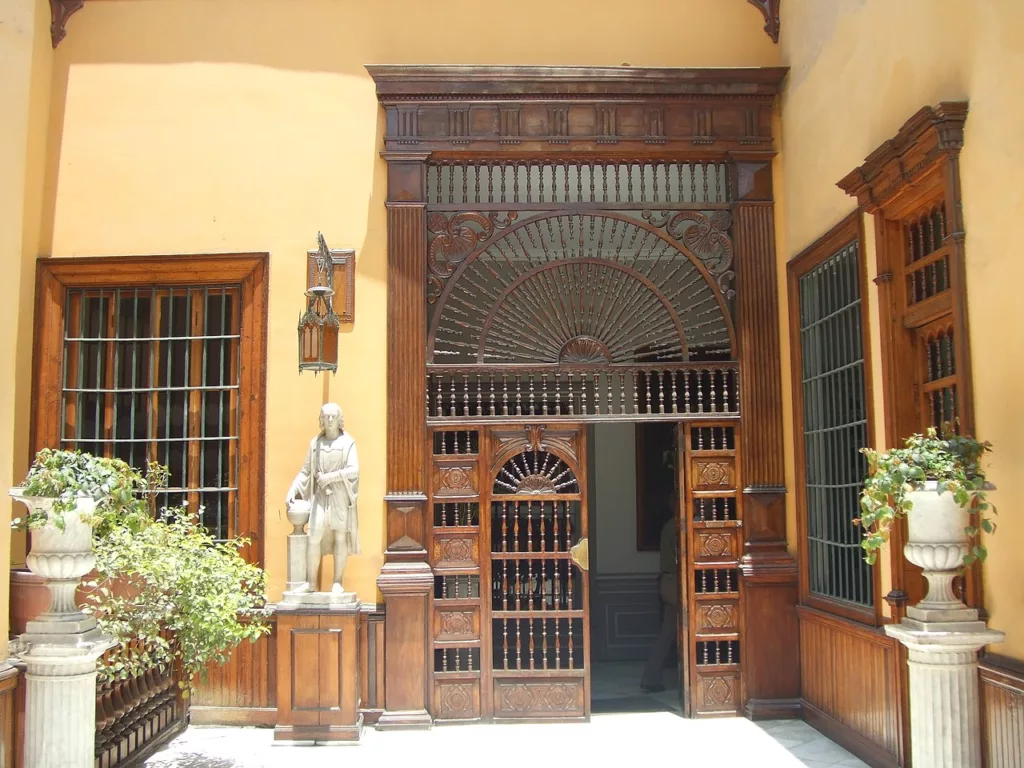
Step back in time at Casa de Aliaga, the oldest continuously inhabited private residence in the Western Hemisphere. Located a stone’s throw away from the Plaza de Armas in Lima’s historic center, this colonial mansion holds a unique place in the city’s history and offers a fascinating insight into Peru’s colonial past.
Built in 1535 upon the foundation of a pre-Columbian pyramid, Casa de Aliaga was granted to Jerónimo de Aliaga, one of Francisco Pizarro’s captains, by the Spanish Crown. Since then, it has been home to 17 generations of the Aliaga family, each leaving their own imprint on the property.
Inside, you’ll find a stunning mix of architectural styles reflecting the different eras of its history. Ornate wooden balconies, colorful tile work, colonial-era furnishings, and an enchanting central courtyard blend together to create an atmosphere of historical grandeur. Each room tells a story, from the Golden Salon with its gilded mirrors and antique furniture, to the Admiral’s Room, named after a family ancestor who fought in the Battle of Ayacucho.
The mansion also houses a collection of religious art and family memorabilia, giving visitors a glimpse into the lives of its inhabitants over the centuries.
Voyagix Tips
Maximize your visit to Casa de Aliaga with these useful tips:
- Book in Advance: Casa de Aliaga is a private residence and visits are by guided tour only. It’s recommended to book in advance through their official website.
- Combine Your Visit: The mansion’s central location makes it easy to combine your visit with other historical sites in Lima’s old town.
- Photography: Feel free to take photos, but respect the privacy of the home and avoid flash photography.
- Guided Tours: The guided tour provides a wealth of information about the history of the house and the Aliaga family. Tours are usually available in English and Spanish.
A visit to Casa de Aliaga is like a journey through time, offering a rare glimpse into Lima’s colonial past. This historical gem is not only an architectural marvel but also a testament to the city’s rich cultural heritage.
16. Attend a Peña Show
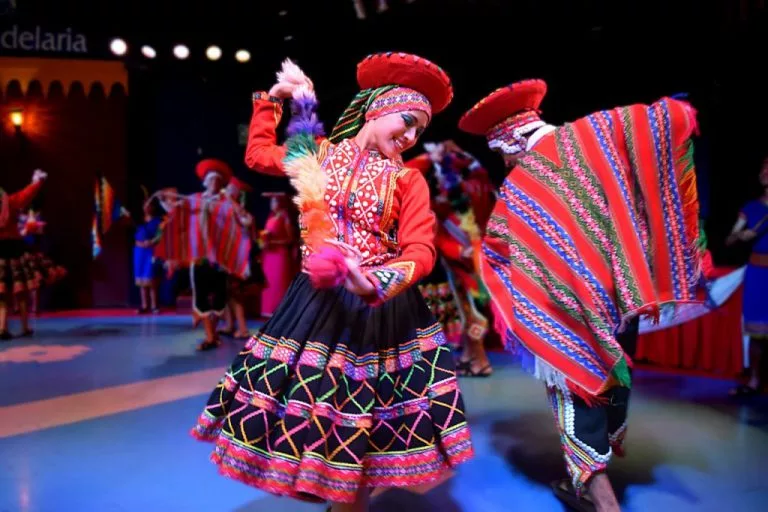
For an unforgettable evening in Lima, experience a Peña show. Peñas are vibrant showcases of Peruvian culture, featuring live performances of traditional music and dance. Housed in local bars and restaurants, these festive gatherings are an integral part of Lima’s nightlife and a wonderful way to immerse yourself in Peru’s rich artistic heritage.
Peña shows present a captivating blend of African, Spanish, and indigenous influences, reflecting the diversity of Peruvian culture. Musicians perform folk tunes on traditional instruments like the charango, cajón, and quena, while dancers in colorful costumes entertain with rhythmic movements and elaborate choreography.
The genres performed at a Peña can vary, but you’re likely to hear marinera, a graceful dance featuring intricate footwork and swirling handkerchiefs, and música criolla, a music style that encompasses waltzes, polkas, and romantic ballads. The atmosphere is invariably festive, with locals and visitors alike clapping along and often joining in the dance.
One of the best-known places to experience a Peña show is the historic La Candelaria, which offers performances every Friday and Saturday night. Here, talented artists deliver passionate performances that are sure to leave you enchanted.
Voyagix Tips
Here are some tips for your Peña show experience:
- Book in Advance: Peña shows can be popular, especially on weekends. It’s recommended to book your table in advance. Check out the La Candelaria website for more information.
- Stay Late: In keeping with Latin tradition, Peña shows often start late and continue into the early hours. Prepare for a long, fun-filled evening.
- Try Local Cuisine: Many Peña venues serve traditional Peruvian dishes. It’s a great opportunity to savor local cuisine while enjoying the show.
- Participate: Don’t be shy to join in the dancing if invited. It’s all part of the fun!
A night at a Peña show is more than just a performance, it’s a celebration of Peru’s vibrant culture. This lively experience is sure to be a highlight of your time in Lima.
17. Visit the Parque de la Reserva
Finally, spend an evening at the Parque de la Reserva, home to the Magic Water Circuit, a Guinness World Record holder for the world’s largest fountain complex. This remarkable park, located in the heart of Lima, features a series of spectacular water fountains, all beautifully lit and choreographed with music.
The Magic Water Circuit is more than just a park; it’s a fairy-tale made of water, lights, and music. There are 13 interactive fountains in total, each offering a unique spectacle. The ‘Fantasia Fountain,’ the park’s crowning glory, presents an enchanting sound and light show, projecting images onto a mist of water. Other highlights include the ‘Tunnel Fountain of Surprises,’ a 35-meter long water tunnel, and ‘The Children’s Fountain,’ which invites young visitors to play among its water jets.
The park’s innovative design is a celebration of water and its transformational powers. Wandering through the park, you can’t help but be swept up in the magic, making it a perfect spot for both families and couples. Whether you’re dancing under a water arch, strolling through the illuminated gardens, or simply marveling at the choreographed displays, the Magic Water Circuit offers an evening of entertainment like no other.
Voyagix Tips
Here are some tips to enhance your visit to the Magic Water Circuit:
- Time Your Visit: The fountains are lit up from sunset, and the main light and water show usually starts after dark. Check the official website for exact timings.
- Prepare to Get Wet: Some fountains are interactive, and you can get wet. It’s part of the fun, but you might want to pack a change of clothes for kids.
- Bring a Camera: The illuminated fountains make for great photographs, so don’t forget your camera.
- Plan for Dinner: There are food vendors in the park, making it a perfect spot for a picnic dinner.
An evening at Parque de la Reserva’s Magic Water Circuit is the perfect end to your day in Lima. With its mesmerizing light and water displays, it promises a magical experience that leaves visitors of all ages spellbound.
Conclusion
In conclusion, Lima is a city that effortlessly blends the ancient and the modern, offering a captivating mix of historical, cultural, and gastronomic experiences. Each of these 17 things to do presents a unique perspective of Lima, ensuring that every traveler leaves with unforgettable memories and a deeper appreciation for this stunning city. From exploring the mysterious Pachacamac Ruins and appreciating the baroque beauty of the Monastery of San Francisco, to savoring the tangy delight of a ceviche at a local eatery or losing yourself in the bohemian vibes of the Barranco District, Lima has something for everyone. So, get ready to step off the plane and plunge into an adventure that is as diverse and colorful as the city itself. With its warm people, captivating history, and mouth-watering food, Lima, Peru is waiting to give you a trip of a lifetime.

